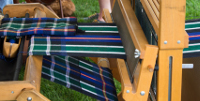In 1767, in their continuing efforts to raise money from the Colonies, where the economy was in really good shape, Parliament passed the Townshend Acts, which "placed new duties on paper, paint, lead, glass, and tea that were imported into the colonies." ** The response from the Colonies should have been expected after the responses to the Sugar Act and the Stamp Act, but either Parliament didn’t concern itself with consequences or it was tone deaf to the way the tide was turning in the Colonies.
One response was the boycott of British goods being imported into America.
The result of this boycott was that American women stopped buying imported fabric, for the most part. So, they were stuck with learning forgotten skills of their mothers and grandmothers.
And they began to spin and weave again.
Most homes had at least one spinning wheel. Many had more than one. They were usually kept upstairs in the "bedrooms". Those rooms were used not only for storage but for work as well. Spinning was one of these jobs. My guess – and it’s only a guess – is that the spinning wheels might have been brought downstairs or even set up outside when it was too hot to work up stairs. The wheels were not all that big and could have been easily moved.
On the other hand, looms were not an item in each home. They were a community item. I can picture weaving bees much like sewing bees. 
Add this work into the daily chores – cleaning, laundry, baking break, cooking, gardening and you have very busy moms.
So when you see reenactors in Revolutionary garb, remember the hands that spun the wool or flax and then wove the fabric to make all the clothes represented there. As I’ve mentioned before, these people had little time for Revolution.
